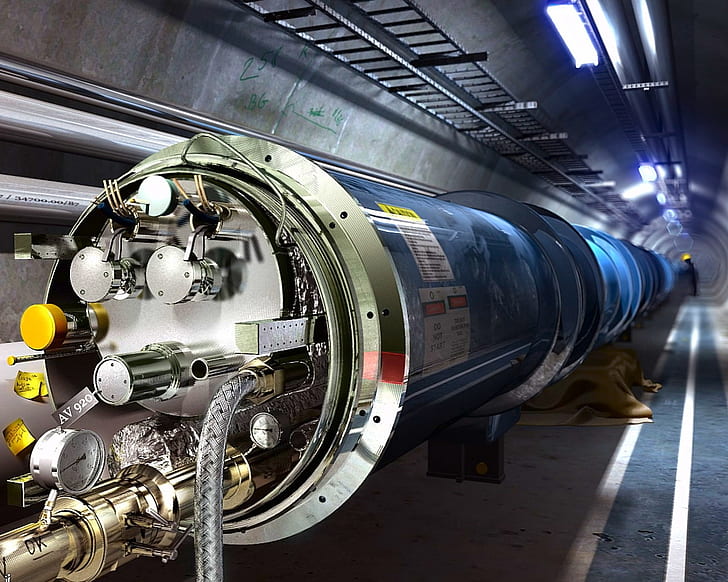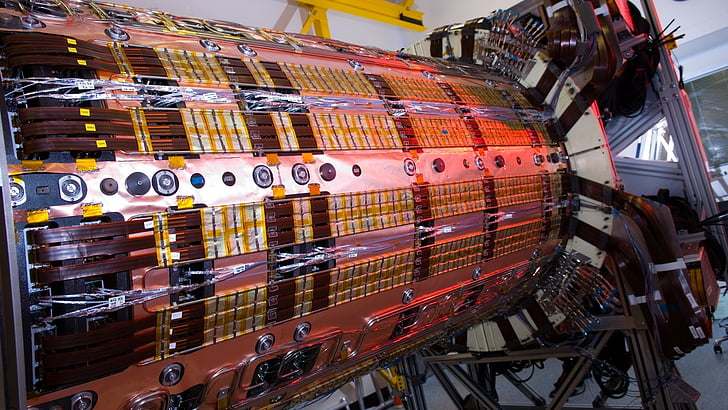HOW,WHAT,WHY,EAGER,EFFICIENCY,BEHIND :- COLLIDERS ?
COLLIDERS
SERIES NAME: - "H.W.W.E.E.B" BY = CHITEKI KUN!-(N.S.R)
BEFORE KNOWING THE THEORY AND PRINCIPLES
SEE IT ONCE , ACCORDING TO ME IT IS ONE OF THE FINEST AND GREATEST INVENTION BY HUMAN
A collider is a type of PARTICLE ACCELARATOR which brings two opposing particle beams together such that the particles collide. Colliders may either be ring accelerators or linear accelerators.
Colliders are used as a research tool in particle physics by accelerating particles to very high kinetic energy and letting them impact other particles. Analysis of the byproducts of these collisions gives scientists good evidence of the structure of the subatomic world and the laws of nature governing it. These may become apparent only at high energies and for tiny periods of time, and therefore may be hard or impossible to study in other ways.
Explanation
In particle physics is gaining knowledge about elementary particles by accelerating particles to very high kinetic energy and letting them impact OR bombard on each other particles. For sufficiently high energy. A reaction occurs that transforms the particles into other particles. While detecting these kind of products it gives insight into the PHYSICS to be involved.
To do such experiments there are two possible setups:
1.Fixed target setup:
A beam of particles (the projectiles) is accelerated with a particle accelerator, and as collision partner, one puts a stationary target into the path of the beam.
2.Collider:
Two beams of particles are accelerated and the beams are directed against each other, so that the particles collide while flying in opposite directions. This process can be used to make strange and anti-matter.
The collider setup is harder to construct but has the great advantage that according to special relativity the energy of an inelastic collision between two particles approaching each other with a given velocity is not just 4 times as high as in the case of one particle resting (as it would be in non-relativistic physics :) it can be orders of magnitude higher if the collision velocity is near the speed of light. damn speed isn't it?
History
The first serious proposal for a collider originated with a group at the Midwestern Universities Research Association (MURA). This group proposed building two tangent radial-sector FFAG accelerator rings.
Tihiro Ohkawa, one of the authors of the first paper, went on to develop a radial-sector FFAG accelerator design that could accelerate two counterrotating particle beams within a single ring of magnets.
The third FFAG prototype built by the MURA group was a 50 MeV electron machine built in 1961 to demonstrate the feasibility of this concept.
Gerard K. O'Neill proposed using a single accelerator to inject particles into a pair of tangent storage rings. As a result the original MURA proposal, collisions would occur in the tangent section.
The benefit of storage rings is that the storage ring can accumulate a high beam flux from an injection accelerator that achieves a much lower flux.
The first electron-positron colliders were built in late 1950s-early 1960s in Italy, at the Istituto Nazionale di Fisica Nucleare in Frascati near Rome, by the Austrian-Italian physicist Bruno Touschek and in the US, by the Stanford-Princeton team that included William C.Barber, Bernard Gittelman, Gerry O’Neill, and Burton Richter. Around the same time, the VEP-1 electron-electron collider was independently developed and built under supervision of Gersh Budker in the Institute of Nuclear Physics in Novosibirsk, USSR. The first observations of particle reactions in the colliding beams were reported almost simultaneously by the three teams in mid-1964 - early 1965.
In 1966, work began on the Intersecting Storage Rings at CERN, and in 1971, this collider was operational.The ISR was a pair of storage rings that accumulated and collided protons injected by the CERN Proton Synchrotron. This was the first hadron collider, as all of the earlier efforts had worked with electrons or with electrons and positrons.
In 1968 construction began on the highest energy proton accelerator complex at Fermilab. It was eventually upgraded to become the Tevatron collider and in October 1985 the first proton-antiproton collisions were recorded at a center of mass energy of 1.6 TeV, making it the highest energy collider in the world, at the time. The energy had later reached 1.96 TeV and at the end of the operation in 2011 the collider luminosity exceeded 430 times its original design goal.
Since 2009, the most high-energetic collider in the world is the Large Hadron Collider (LHC) at CERN. It currently operates at 13 TeV center of mass energy in proton-proton collisions. More than a dozen future particle collider projects of various types - circular and linear, colliding hadrons (proton-proton or ion-ion), leptons (electron-positron or muon-muon), or electrons and ions/protons - are currently under consideration for detail exploration of the Higgs/electroweak physics and discoveries at the -LHC energy frontier.
A SNEAK PEAK ABOUT THE LHC energy frontier.
The Large Hadron Collider (LHC) is the world’s largest and most powerful particle accelerator. It first started up on 10 September 2008, and remains the latest addition to CERN’s accelerator complex. The LHC consists of a 27-kilometre ring of superconducting magnets with a number of accelerating structures to boost the energy of the particles along the way.
Inside the accelerator, two high-energy particle beams travel at close to the speed of light before they are made to collide. The beams travel in opposite directions in separate beam pipes – two tubes kept at ultrahigh vacuum. They are guided around the accelerator ring by a strong magnetic field maintained by superconducting electromagnets. The electromagnets are built from coils of special electric cable that operates in a superconducting state, efficiently conducting electricity without resistance or loss of energy. This requires chilling the magnets to ‑271.3°C – a temperature colder than outer space. For this reason, much of the accelerator is connected to a distribution system of liquid helium, which cools the magnets, as well as to other supply services.LS1, Magnets, TI2, PMI2, LHC, dipole, descent, replacement
Thousands of magnets of different varieties and sizes are used to direct the beams around the accelerator. These include 1232 dipole magnets 15 metres in length which bend the beams, and 392 quadrupole magnets, each 5–7 metres long, which focus the beams. Just prior to collision, another type of magnet is used to "squeeze" the particles closer together to increase the chances of collisions. The particles are so tiny that the task of making them collide is akin to firing two needles 10 kilometres apart with such precision that they meet halfway.All the controls for the accelerator, its services and technical infrastructure are housed under one roof at the CERN Control Centre. From here, the beams inside the LHC are made to collide at four locations around the accelerator ring, .Corresponding to the positions of four particle detectors – ATLAS, CMS, ALICE and LHCb.
TO BE CONTINUEEED
WITH THESE
a sneak peek
1st clue








Comments
Post a Comment